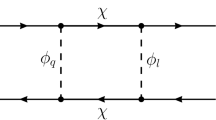Abstract
In many models stability of dark matter particles D (with mass M D ) is ensured by a new conserved quantum number which we call the D-parity. We consider models which also contain charged D-odd particle D ± (with mass M ±). We study the process e + e − → D + D − followed by decay of D ± to D and gauge bosons W (either on-shell or off-shell). Measuring the end points of the energy distribution of W’s would determine M D and M ±. However, the hadron mode of W decay would lead to low precision in this measurement. while the information from the lepton mode looks incomplete. I show that it is sufficient to measure the energy distribution of a single lepton (for definiteness μ) in the process e + e − → μ + 2jets + large missing E T . The well identified singularities in this distribution allow for determination of M D and M ± with a high precision. After that, measuring the corresponding cross section will allow one to determine the spin of D particles.
Similar content being viewed by others
References
D. Hooper, “TASI 2008 Lectures on Dark Matter,” arXiv:0901.4090; M. Maniatis, “The Next-to-Minimal Supersymmetric Extension of the Standard Model Reviewed,” Int. J. Mod. Phys. A 25, 3505–3602 (2010); D. I. Kazakov, “Supersymmetry on the Run: LHC and Dark Matter,” Nucl. Phys. Proc. Suppl. 203–204, 118–154 (2010); J. Ellis, “New Light on Dark Matter from the LHC,” arXiv:1011.0077.
N. G. Deshpande and E. Ma, “Pattern of Symmetry Breaking with Two Higgs Doublets,” Phys. Rev. D: Part. Fields 18, 2574 (1978); R. Barbieri, L. J. Hall, and V. S. Rychkov, “Improved Naturalness with a Heavy Higgs: an Alternative Road to LHC Physics,” Phys. Rev. D: Part. Fields 74, 015007 (2006); I. F. Ginzburg, K. A. Kanishev, M. Krawczyk, and D. Soko owska, “Evolution of Universe to the Present Inert Phase,” Phys. Rev. D: Part. Fields 82, 123533 (2010).
E. Lundstrom, M. Gustafsson, and J. Edsjo, “The Inert Doublet Model and LEP II Limits,” Phys. Rev. D: Part. Fields 79, 035013 (2009).
E. M. Dolle and S. Su, “The Inert Dark Matter,” Phys. Rev. D: Part. Fields 80, 055012 (2009); E. Dolle, X. Miao, S. Su, and B. Thomas, “Dilepton Signals in the Inert Doublet Model,” Phys. Rev. D: Part. Fields 81, 035003 (2010); L. Lopez Honorez, E. Nezri, J. F. Oliver, and M. H. G. Tytgat, “The Inert Doublet Model: An Archetype for Dark Matter,” JCAP 0702, 028 (2007); E. Nezri, M. H. G. Tytgat, and G. Vertongen, “e+ and Anti-p from Inert Doublet Model Dark Matter,” JCAP 0904, 014 (2009); S. Andreas, T. Hambye, and M. H. G. Tytgat, “WIMP Dark Matter, Higgs Exchange and DAMA,” JCAP 0810, 034 (2008); L. Lopez Honorez and C. E. Yaguna, “The Inert Doublet Model of Dark Matter Revisited,” JHEP 1009, 046 (2010).
G. I. Kopylov, Just so Kinematics (Nauka, Moscow, 1981) [in Russian]; R. D. Heuer et al., “TESLA Technical Design Report,” DESY 2001-011, TESLA Report 2001-23, TESLA FEL 2001-05 (2001); Particle Data Group, “The Review of Particle Physics,” J. Phys. G 37, 075021 (2010).
Author information
Authors and Affiliations
Corresponding author
Additional information
The article is published in the original.
Rights and permissions
About this article
Cite this article
Ginzburg, I.F. Measuring of mass and spin of dark matter particles at ILC. Phys. Part. Nuclei Lett. 9, 678–685 (2012). https://doi.org/10.1134/S1547477112070059
Published:
Issue Date:
DOI: https://doi.org/10.1134/S1547477112070059



